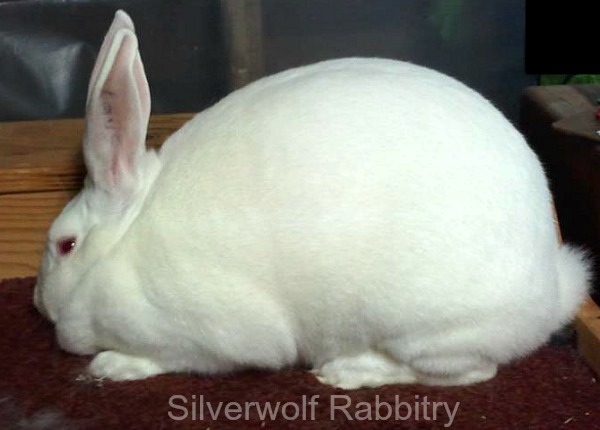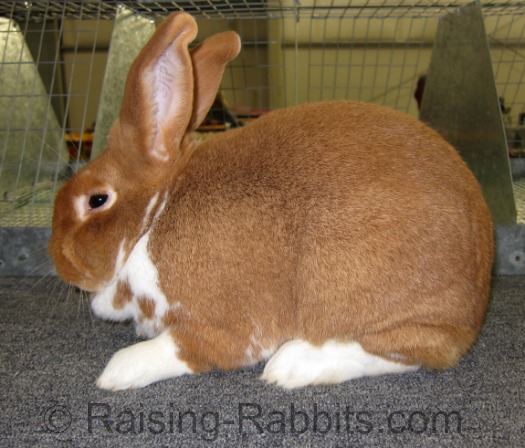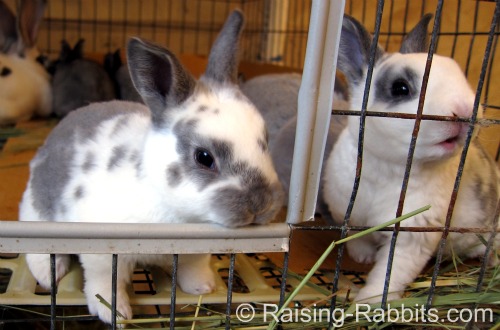Commercial Rabbit Production
Profitability
By Carla Carter, Owner of Rabbits4U
In commercial rabbit production, the difference between profitable and unprofitable is the ability of your fryer rabbits to reach 5 pounds in weight within 8 weeks from birth.
This is because every day past 8 weeks costs more money out of your pocket in the form of additional expensive rabbit feed and cage space that is not available for youngsters or for a newly bred doe.
Here are 5 factors that when managed correctly, will result in 5 pound fryers in 8 weeks, enhancing commercial rabbit production profitability.
1: Feed
I feed an 18% protein, 18% fiber (minimum) and a low fat feed, actually 1.5 – 2% fat.
On 18% protein your doe will have the nutrients to conceive and kindle several more kits per litter and raise them to weaning age. 18% fiber is an essential minimum for keeping the rabbit’s digestive tract and its intestinal flora balanced and healthy.
The 1.5 – 2% fat level assists in preventing excessive build-up of fats in the rabbit’s body, while providing enough of the essential fats for body functions and for lactation.
 This is one solid-as-a-brick New Zealand White Rabbit. Get yours from a commercial rabbitry with a proven track record.
This is one solid-as-a-brick New Zealand White Rabbit. Get yours from a commercial rabbitry with a proven track record.2: Stock
Excellent stock will raise excellent, quick-growing offspring, while
garbage stock will result in undersized or spotty results. Therefore obtain
your foundation stock from a rabbitry with a proven commercial track record.
No sense in having to reinvent the wheel. Verify – ask to see records.
To evaluate your present stock, weigh
your does and bucks. If your adult animals weigh only 8 pounds, you are probably
wasting your time with these animals. They are small stock and will have small
offspring. You need a minimum of a 10-pound doe and a 9-10-pound
buck.
Weight alone is not the only
criteria, as in many instances, larger is not always better. Giant breeds
require heavy bones to support their giant frames. Heavy bones mean less meat
and a reduced meat-to-bone ratio, meaning, more waste.
Stick with the tried and trusty meat
breeds, the Californians and/or New Zealands, especially as you get started,
and you’ll optimize your chances for good profitability. For Cals and New Zealands,
your stock should weigh between 10 pounds for Cals, to 10-12 pounds for New Zealand.
Pine Shavings packaged as horse bedding but perfect for rabbit nest boxes:
3: Rabbit Husbandry
 New Zealand Broken Red Rabbit. Get yours from a commercial rabbitry with a track record.
New Zealand Broken Red Rabbit. Get yours from a commercial rabbitry with a track record.Provide pellets and water accessible to the kits just as soon as they leave the
nest box. I put feed and water down in feeders low on the cage in small low
bowls as soon as the kits leave the nest box. I don’t wait until they are big
enough to get to the j-feeders even if the feeders are low. The sooner you have
them on pellets, the faster they will grow.
As the young kits grow, they like to all eat at the same time. You will see them all rally around the feed bowls when given the opportunity. It is basically the herd mentally. Providing long feeders with enough room for “everybody at the trough” ensures that all will eat and grow at the same pace.
I like to use the 11 inch feeders in my 30X36 inch cages for this reason. In addition I often have a bowl or crock in the cage separate as well. As they grow they need more room and access to more space for feeding. So, provide ample feed and eating space all the time. Yes, they will eat a lot of feed, but it turns into faster weight gain and faster money turn around, very important in commercial rabbit production.
The same is true for the watering systems. One water bottle on a cage for 4 or 5 young fryers simply isn’t enough to provide “full watering.” I like to have multiple nipples available or open water bowls in the cage for them. Clean fresh water every day makes a world of difference. They won’t eat if there isn’t any water.
Edstrom - the Gravity-Fed Auto-Watering System I Love:
4: Weaning
Wean the kits at 28 days. The faster they are weaned, the faster they will grow. Breeding the doe back at two weeks helps this process. By the 4 week time slot typically she has them weaned herself because her milk is drying up preparing her for her next litter. I find it easiest to remove the doe and leave the kits in the original cage. Another reason I would prefer that ALL my cage be 30X36 so I don’t have to worry about moving animals around to make sure they are in the size of cage they need to be.
Build your own Cages:
5: Cage Space
Keep the fryers in cages that offer plenty of moving room. For example, 4-6 weanlings to a 30x36 cage gives ample room. Ensure FULL ACCESS to water 24/7 and feeders ALWAYS full. Full means all the way to the top with the feed pushed down through and filling the inside of the feeder all the way up as well. Don’t always count on the feeders to self-fill as they should. Sometimes they get blocked up or even wet for some reason.
 Three-week-old kits are active and growing like weeds. These are Rex, too small for commercial meat production. You'll need New Zealands, Californians, or Production Whites.
Three-week-old kits are active and growing like weeds. These are Rex, too small for commercial meat production. You'll need New Zealands, Californians, or Production Whites.Or, purchase commercially built cages:
Don’t forget that in commercial rabbit production, cage space is like retail space
Wal-Mart makes no money if products don’t fly off
their shelves. And you will LOSE money if you aren’t moving rabbits out and
moving more rabbits into your cages. You need to be marketing your rabbits at 8
weeks and refilling those nice big cages.
If your stock is commercial grade, your feed is good and
your husbandry practices are on the mark as per these basics, your commercial rabbit production enterprise should have
no problems producing 5-pound rabbits in 8 weeks.
More links you may like:
- Raising Rabbits for Meat: Intro to Commercial Rabbit Production
- Feeding Commercial Rabbits for Rapid Growth
- Rabbit Diseases
Double-Value Guarantee
Our policy is to always OVER-deliver
on value,
which is why your purchase is fully covered by our
Double-Value
Guarantee.
Go ahead - take any of our e-books for a test drive. Peruse our detailed informational and educational e-books. Examine our plans for building rabbit cages, runs, or metal or PVC hutch frames. Check out the Rabbit Husbandry info e-books.
If you aren't completely satisfied that your e-book purchase is worth at least double, triple or even quadruple the price you paid, just drop us a note within 45 days, and we'll refund you the entire cost. That's our Double-Value Guarantee.
Note: When you purchase your
e-books, they will be in PDF format, so you can download them to any device that
supports PDF format. We advise making a back-up copy to a drive or cloud
account. If the books are lost, you can also purchase another copy from Raising-Rabbits.










New! Comments
Have your say about what you just read! Leave me a comment in the box below.